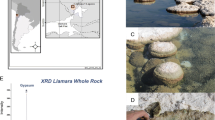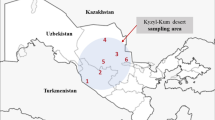Abstract
Microbial particles transported by Asian desert dust (KOSA) possibly impact ecosystems and human health in downwind environments and are commonly called “bioaerosols.” The microbial communities associated with KOSA mineral particles (KOSA bioaerosol), which were collected from the snow cover on Mt. Tateyama, were investigated by means of a culture-amendment technique combined with denaturing gradient gel electrophoresis (DGGE) analysis using 16S rRNA genes. After the stratigraphy of the snow layer formed on the walls of a snow pit on Mt. Tateyama, samples were collected from 2 layers, which included KOSA particles and one which did not. The snow samples with KOSA particles indicated microbial growth in the 100 and 10−1 dilution media and in the medium with NaCl below 10%, while the snow sample without KOSA particles showed no microbial growth in the culture media. The PCR–DGGE analysis revealed that the bacterial compositions in the snow samples including KOSA mineral particles were mainly composed of the members of the phyla Actinobacteria, Firmicutus, and Proteobacteria. In particular, the 2 phylotypes appeared in the microbial cultures were similar to the members of the B. subtilis group, which has been detected in bioaerosol samples collected from the atmosphere over KOSA arrival (Suzu City) and source (Dunhuang City) regions. Presumably, halotolerant and oligotrophic bacterial communities are associated with the KOSA particles that descend to the snow cover on Mt. Tateyama.




Similar content being viewed by others

References
Alabouvette, C., Hoeper, H., Lemanceau, P., & Steinberg, C. (1996). Soil suppressiveness to diseases induced by soil-borne plant pathogens. Soil Biochemistry, 9, 371–413.
Alan, M. J., & Harrison, R. M. (2004). The effects of meteorological factors on atmospheric bioaerosol concentrations—a review. Science of Total Environment, 326, 151–180.
Aoki, K., & Watanabe, K. (2009). Measurements of atmospheric aerosol at Mt. Tateyama, Japan. Earozoru Kenkyu, 24, 112–116. (in Japanese).
Ashiuchi, M., & Misono, H. (2002). Biochemistry and molecular genetics of poly-γ-glutamate synthesis. Applied Microbiological Biotechnology, 59, 9–14.
Blenkinsopp, S. A., & Costerton, J. W. (1991). Understanding bacterial biofilms. Trends in Biotechnology, 9, 138–143.
Bowers, R. M., Lauber, C. L., Wiedinmyer, C., Hamady, M., Hallar, A. G., Fall, R., et al. (2009). Characterization of airborne microbial communities at a high-elevation site and their potential to act as atmospheric ice nuclei. Applied and Environmental Microbiology, 75, 5121–5130.
Castorena, G., Mugica, V., Le Borgne, S., Acuna, M. E., Bustos-Jaimes, I., & Aburto, J. (2006). Carbazole biodegradation in gas oil/water biphasic media by a new isolated bacterium Burkholderia sp. strain IMP5GC. Journal of Applied Microbiology, 100, 739–745.
Collins, M. D., Hoyles, L., Tornqvist, E., von Essen, R., & Falsen, E. (2001). Characterization of some strains from human clinical sources which resemble Leptotrichia sanguinegens: description of Sneathia sanguinegens sp. nov., gen. nov. Systematic and Applied Microbiology, 24, 358–361.
Das, K., & Mukherjee, A. K. (2007). Crude petroleum-oil biodegradation efficiency of Bacillus subtilis and Pseudomonas aeruginosa strains isolated from a petroleum-oil contaminated soil from North-East India. Bioresource Technology, 98, 1339–1345.
Duce, R. A., Unni, C. K., Ray, B. J., Prospero, J. M., & Merrill, J. T. (1980). Long-range atmospheric transport of soil dust from Asia to the tropical North Pacific: temporal variability. Science, 209, 1522–1524.
Eady, E. A., Gloor, M., & Leyden, J. J. (2003). Propionibacterium acnes resistance: a worldwide problem. Dermatology, 206, 54–56.
Echigo, A., Hino, M., Fukushima, T., Mizuki, T., Kamekura, M., & Usami, R. (2005). Endospores of halophilicbacteria of the family Bacillaceae isolated from non-saline Japanese soil may be transported by Kosa event (Asian duststorm). Saline Systems, 2005, 1–8.
Feurer, C., Clermont, D., Bimet, F., Candrea, A., Jackson, M., Glaser, P., et al. (2004). Taxonomic characterization of nine strains isolated from clinical and environmental specimens, and proposal of Corynebacterium tuberculostearicum sp. nov. International Journal of Systematic and Evolutionary Microbiology, 54, 1055–1061.
Griffin, D. W., Kellogg, C. A., Garrison, V. H., Lisle, J. T., Borden, T. C., & Shinn, E. A. (2003). Atmospheric microbiology in the northern Caribbean during African dust. Aerobiologia, 19, 143–157.
Hayward, A. C. (1991). Biology and epidemiology of bacterial wilt caused by Pseudomonas solanacearum. Annual review of Phytopathology, 29, 65–87.
Hua, N. P., Kobayashi, F., Iwasaka, Y., Shi, G. Y., & Naganuma, T. (2007). Detailed identification of desert-originated bacteria carried by Asian dust storms to Japan. Aerobiologia, 23, 291–298.
Imshenetsky, A. A., Lysenko, S. V., & Kazakov, G. A. (1978). Upper boundary of the biosphere. Applied and Environmental Microbiology, 35, 1–5.
Iwasaka, Y., Minoura, H., & Nagaya, K. (1983). The transport and spacial scale of Asian dust-storm clouds: a case study of the dust-storm event of April 1979. Tellus, 35B, 189–196.
Iwasaka, Y., Shi, G. Y., Yamada, M., Kobayashi, F., Kakikawa, M., Maki, T., et al. (2009). Mixture of Kosa (Asian dust) and bioaerosols detected in the atmosphere over the Kosa particles source regions with balloon-borne measurements: possibility of long-range transport. Air Quality, Atmosphere & Health, 2, 29–38.
Jaenicke, R. (2005). Abundance of cellular material and proteins in the atmosphere. Science, 308, 73.
Jones, A. M., & Harrison, R. M. (2004). The effects of meteorologicalfactors on atmospheric bioaerosol concentrations—a review. Science of Total Environment, 326, 151–180.
Kakikawa, M., Kobayashi, F., Maki, T., Yamada, M., Higashi, T., Chen, B., et al. (2009). Dustborne microorganisms in the atmosphere over Asian dust (KOSA) source region, Dunhuang. Air Quality, Atmosphere & Health, 1, 195–202.
Kellogg, C. A., Griffin, D. W., Garrison, V. H., Peak, K. K., Royal, N., Smith, R. R., et al. (2004). Characterization of aerosolized bacteria and fungi from desert dust events in Mali, West Africa. Aerobiologia, 20, 99–110.
Kobayashi, F., Kakikawa, M., Yamanda, M., Chen, B., Shi, G. Y., & Iwasaka, Y. (2007). Study on atmospheric diffusion of bioaerosols in a KOSA source region. Earozoru Kenkyu, 22, 218–227. (in Japanese).
Maki, T., Susuki, S., Kobayashi, F., Kakikawa, M., Tobo, Y., Yamada, M., et al. (2010). Phylogenetic analysis of atmospheric halotolerant bacterial communities at high altitude in an Asian dust (KOSA) arrival region, Suzu City. Science of Total Environment, 408, 4556–4562.
Maki, T., Susuki, S., Kobayashi, F., Kakikawa, M., Yamada, M., Higashi, T., et al. (2008). Phylogenetic diversity and vertical distribution of a halobacterial community in the atmosphere of an Asian dust (KOSA) source region, Dunhuang City. Air Quality, Atmosphere & Health, 1, 81–89.
Maron, P. A., Lejon, D. P. H., Carvalho, E., Bizet, K., Lemanceau, P., Ranjard, L., et al. (2005). Assessing genetic structure and diversity of airborne bacterial communities by DNA fingerprinting and 16S rDNA clone library. Atmospheric Environment, 39, 3687–3695.
Morita, R. Y. (1990). The starvation-survival state of microorganisms in nature and its relationship to the bioavailable energy. Cellular and Molecular Life Sciences, 46, 813–817.
Muyzer, G., de Waal, E. C., & Uitterlinden, A. G. (1993). Profiling of complex microbial populations by denaturing gradient gel electrophoresis analysis of polymérase chain reaction-amplified genes coding for 16S rRNA. Applied and Environmental Microbiology, 59, 695–700.
Okamoto, T., Maruyama, A., Imura, S., Takeyama, H., & Naganuma, T. (2004). Comparative phylogenetic analyses of Halomonas variabilis and related organisms based on 16S rRNA, gyrB and ectBC gene sequences. Systematic and Applied Microbiology, 27, 323–333.
Olsen, R. A., & Bakken, L. R. (1987). Viability of soil bacteria, optimization of plate-counting technique and comparison between total counts and plate counts within different size groups. Microbial Ecology, 13, 59–74.
Osada, K., Iida, H., Kido, M., Matsunaga, K., & Iwasaka, Y. (2004). Mineral dust layers in snow at Mount Tateyama, Central Japan: formation processes and characteristics. Tellus, 56B, 382–392.
Paster, B. J., Falkler, W. A., Jr., Enwonwu, C. O., Idigbe, E. O., Savage, K. O., Levanos, V. A., et al. (2002). Prevalent bacterial species and novel phylotypes in advanced noma lesions. Journal of Clinical Microbiology, 40, 2187–2191.
Pratt, K. A., DeMott, P. J., French, J. R., Wang, Z., Westphal, D. L., Heymsfield, A. J., et al. (2009). In situ detection of biological particles in cloud ice-crystals. Nature Geoscience, 2, 398–401.
Prospero, J. M., Blades, E., Mathison, G., & Naidu, R. (2005). Interhemispheric transport of viable fungi and bacteria from Africa to the Caribbean with soil dust. Aerobiologia, 21, 1–19.
Richard, V., Van der Auwera, P., Snoeck, R., Daneau, D., & Meunier, F. (1988). Nosocomial bacteremia caused by Bacillus species. European Journal of Clinical Microbiology and Infectious Diseases, 7, 783–785.
Riesenman, P. J., & Nicholson, L. (2000). Role of the spore coat layers in Bacillus subtilis spore resistance to hydrogen peroxide, artificial UV-C, UV-B, and solar UV radiation. Applied and Environmental Microbiology, 66, 620–626.
Rothschild, L. J., & Mancinelli, R. L. (2001). Life in extremeenvironments. Nature, 409, 1092–1100.
Russell, W. C., Newman, C., & Williamson, D. H. (1974). A simple cytochemical technique for demonstration of DNA in cells infected with mycoplasms and viruses. Nature, 253, 461–462.
Saitou, N., & Nei, M. (1987). The neighbor-joiningmethod: A new method for reconstructing phylogenetic trees. Molecular Biology and Evolution, 4, 406–425.
Silbaq, S. (2009). Viable ultramicrocells in drinking water. Journal of Applied Microbiology, 106, 106–117.
Smith, N. H., Holmes, E. C., Donovan, G. M., Carpenter, G. A., & Spratt, B. G. (1999). Networks and groups within the genus Neisseria: analysis of argF, recA, rho, and 16S rRNA sequences from human Neisseria species. Molecular Biology and Evolution, 16, 773–783.
Suzuki, K., & Tsunogai, S. (1993). Origin of calcium in aerosol over the western north Pacific. Journal of Atmospheric Chemistry, 6, 363–374.
Velasco, E., Martins, C. A., Tabak, D., & Bouzas, L. F. (1992). “Bacillus subtilis” infection in a patient submitted to a bone marrow transplantation. Revista Paulista de Medicina, 110, 116–117.
Wang, W., Ma, Y., Ma, X., Wu, F., Ma, X., An, L., et al. (2010). Seasonal variations of airborne bacteria in the Mogao Grottoes, Dunhuang, China. International Biodeterioration & Biodegradation, 64, 309–315.
Willems, A., Falsen, E., Pot, B., Jantzen, E., Hoste, B., Vandamme, P., et al. (1990). Acidovorax, a new genus for Pseudomonas facilis, Pseudomonas delafieldii, E. Falsen (EF) group 13, EF group 16, and several clinical isolates, with the species Acidovorax facilis comb. nov., Acidovorax delafieldii comb. nov., and Acidovorax temperans sp. nov. International Journal of Systematic and Evolutionary Microbiology, 40, 384–398.
Yeo, H. G., & Kim, J. H. (2002). SPM and fungal spores in the ambient air of west Korea during the Asian dust (Yellow sand) period. Atmospheric Environment, 36, 5437–5442.
Zhang, D., Iwasaka, Y., Matsuki, A., Ueno, K., & Matsuzaki, T. (2006). Coarse and accumulation mode particles associated with Asian dust in southwestern Japan. Atmospheric Environment, 40, 1205–1215.
Acknowledgments
We thank H. Honoki (Toyama Science Museum) and A. Takahashi (University of Toyama) for their chemical analysis using ion chromatography. This research was supported by a Grant-in-Aid for the Encouragement of Young Scientists (22681005) from the Ministry of Education, Science, Sports, and Culture, Japan. The Global Environment Research Fund (C-091) provided by the Ministry of the Environment, Japan also supported this work.
Author information
Authors and Affiliations
Corresponding author
Rights and permissions
About this article
Cite this article
Maki, T., Aoki, K., Kobayashi, F. et al. Characterization of halotolerant and oligotrophic bacterial communities in Asian desert dust (KOSA) bioaerosol accumulated in layers of snow on Mount Tateyama, Central Japan. Aerobiologia 27, 277–290 (2011). https://doi.org/10.1007/s10453-011-9196-0
Received:
Accepted:
Published:
Issue Date:
DOI: https://doi.org/10.1007/s10453-011-9196-0



